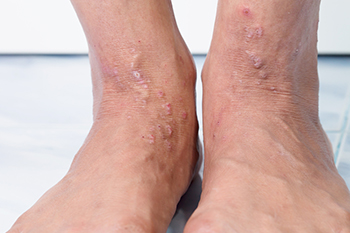
Buschke-Ollendorff syndrome, or BOS, manifests with distinctive symptoms that can affect the feet. This rare condition combines skin and bone abnormalities and is characterized by skin lesions and bone spots on the feet. Skin lesions result from connective tissue irregularities and appear as spots, while bone spots are painless areas of heightened bone density, detectable through X-rays. Symptoms usually begin in childhood, and although the skin lesions may progress with age, they typically do not lead to additional health concerns. However, in rare instances, BOS can advance to melorheostosis, causing abnormal bone growth, potentially resulting in bone pain and deformities within the feet. Diagnosis hinges on clinical examination, imaging studies, and genetic testing. If you have foot pain of any type, it is suggested that you schedule an appointment with a podiatrist for a proper diagnosis and appropriate treatment.
Some foot conditions may require additional professional care. If you have any concerns, contact one of our podiatrists of Michigan Foot & Ankle Center. Our doctors can provide the care you need to keep you pain-free and on your feet.
Rare Foot Conditions
The majority of foot conditions are common and can be treated by a podiatrist. Standard diagnostic procedures are generally used to identify specific conditions and treatment can be rendered. A podiatrist also treats rare foot conditions which can be difficult to diagnose and may need extra attention and care.
There are many rare foot conditions that can affect children. Some of these can include:
- Freiberg’s disease
- Kohler’s disease
- Maffucci syndrome
Freiberg’s disease - This can be seen as a deterioration and flattening of a metatarsal bone that exists in the ball of the foot. It typically affects pre-teen and teenage girls, but can affect anyone at any age. Symptoms that can accompany this can be swelling, stiffness, and the patient may limp.
Kohler’s disease - This often targets the bone in the arch of the foot and affects younger boys. It can lead to an interruption of the blood supply which ultimately can lead to bone deterioration. The patient may limp or experience tenderness, swelling, and redness.
Maffucci syndrome - This affects the long bones in a child’s foot leading to the development of abnormal bone lesions. They are benign growths and typically develop in early childhood and the bones may be susceptible to breaking.
A podiatrist can properly diagnose and treat all types of rare foot conditions. If your child is affected by any of these symptoms or conditions, please don’t hesitate to call our office so the correct treatment method can begin.
If you have any questions please feel free to contact one of our offices located in Livonia, and Southfield, MI . We offer the newest diagnostic tools and technology to treat your foot and ankle needs.
